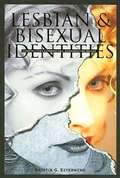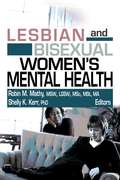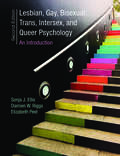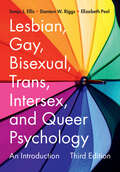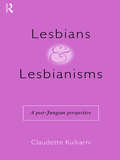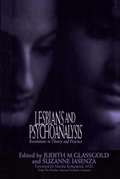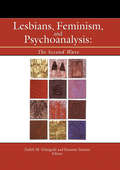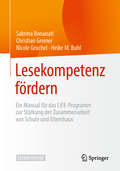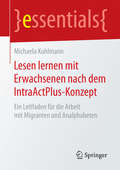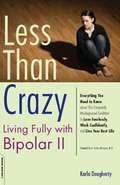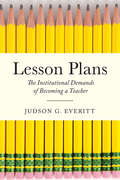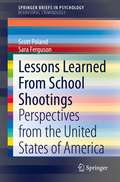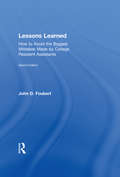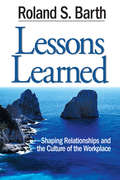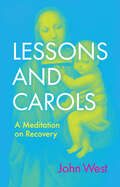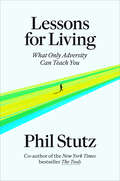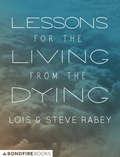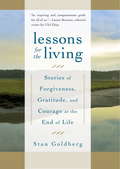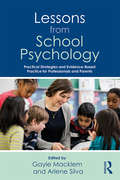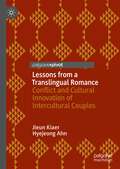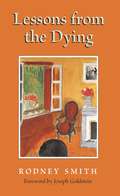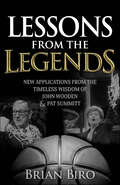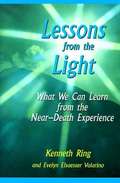- Table View
- List View
Lesbian and Bisexual Identities: Constructing Communities, Constructing Selves
by Kristin G. EsterbergThis book examines the stories of lesbian and bisexual women in a Northeast community who share who they are, how they have come to see themselves as lesbian or bisexual, and what those identities mean to them. Drawing on social constructionist approaches to identity, Kristin G. Esterberg argues that identities are multiple and contingent. Created within the context of specific communities and within specific relationships, lesbian and bisexual identities are ways of sorting through experiences of desires and attractions, relationships, and politics. Their meanings change over time as women grow older and have more varied experiences, as the communities and sociopolitical worlds in which they live change, and as their life circumstances alter. In interviews conducted over a four-year time period, women describe the lesbian community they live in; how they see its structure, its social groups, its informal rules and norms for behavi and their places inside -- or on the margins of -- the community. Lesbian and Bisexual Identities reveals how women fall in and out of love, how they "perform" lesbian or bisexual identity through clothing, hairstyle, body language, and talk, and many other aspects typically not considered. The women present a variety of accounts. Some consider themselves "lesbian from birth" and have constructed their lives accordingly, while others have experienced significant shifts in their identities, depending on the influences of feminism, progressive politics, the visibility of the lesbian community, and other factors. Esterberg offers vivid accounts that defy the stereotypes so commonly offered. Lesbian and Bisexual Identities not only presents women's stories in their own words, it moves beyond storytelling to understand how these accounts resonate with social science theories of identity and community.
Lesbian and Bisexual Women's Mental Health
by Robin M. Mathy and Shelly K. KerrExamine the psychosocial factors that affect lesbian and bisexual women&’s mental healthThis essential guide presents up-to-date, evidence-based information that can be implemented to improve mental health services for lesbian and bisexual women in a variety of settings. It examines the systemic factors that play a role in their psychological and emotional well-being, and presents new research on protective factors that play an important role when lesbian/bisexual women face depression, anxiety, and other mental health disorders.Lesbian and Bisexual Women&’s Mental Health reviews the past literature on mental health and sexual orientation-citing biased and inadequate assessment, diagnosis, and treatment approaches currently in use in the care of lesbian and bisexual women. This essential guide for clinicians and researchers presents new empirical research on lesbian/bisexual women&’s mental health. It explores specific challenges that face various lesbian and bisexual female populations, with research on: dysthymia depression and anxiety-including a chapter on depressive distress among African-American women the way that community size and religiosity impact lesbian/bisexual women&’s psychosexual development the relationship between shame and a client&’s attachment style the mental health implications of same-sex marriage mental health in Taiwan&’s T-Po lesbian community-with a focus on community members&’ sexual orientation, gender roles, and gender identity the interconnectedness of sexual fantasies, psychological adjustment, and close relationship functioning in lesbian/bisexual women body image and eating issuesAs the diversity of this population becomes progressively more evident, so does the necessity for deeper exploration of the mental health problems facing lesbians and bisexuals. Whether you are a student, an educator, or an experienced clinician, Lesbian and Bisexual Women&’s Mental Health is an essential resource for relevant and meaningful information that focuses much-needed attention on the mental health of lesbian and bisexual women.
Lesbian, Gay, Bisexual, Trans, Intersex, and Queer Psychology: An Introduction
by Sonja J. Ellis Elizabeth Peel Damien W. RiggsThe second edition of this award-winning textbook provides an accessible and engaging introduction to the field of lesbian, gay, bisexual, transgender, intersex, and queer psychology. Comprehensive in scope and international in outlook, it offers an integrated overview of key topical areas, from history and context, identities and fluidity, families and relationships, to health and wellbeing. The second edition has been extensively revised to address substantial developments and emerging areas, such as people born with intersex variations, transgender and non-binary genders, intersectionality, and gender-diverse children. It also includes new pedagogical features to support learning and to facilitate discussion and reflection, with feature boxes throughout that explain important concepts, provide concise overviews of cutting-edge research, and offer first-person narratives that bring topics to life. This pioneering textbook is an essential resource for undergraduate courses on sex, gender, and sexuality in psychology and related disciplines, such as sociology, health studies, social work, education, and counselling.
Lesbian, Gay, Bisexual, Trans, Intersex, and Queer Psychology: An Introduction
by Sonja J. Ellis Damien W. Riggs Elizabeth PeelThe third edition of this award-winning textbook provides an accessible and engaging introduction to the field of LGBTIQ+ psychology. Comprehensive in scope and international in outlook, it offers an integrated overview of key topical areas, from history and context, identities and fluidity, families and relationships, to health and wellbeing. This third edition includes updates across all chapters that provide a greater focus on diversity and utilize new terminology throughout to reflect changes in the field. It addresses recent developments in the field of trans studies, and explicitly references emerging work around pansexuality and asexuality. An entirely new chapter focuses on a diversity of topics receiving increased attention including LGBTIQ+ people in foster care, LGBTIQ+ refugees, disabled people accessing services, and trans and intersex people in sport. The fallout of increasing far-right extremism in Europe and America is also discussed. This groundbreaking textbook is an essential resource for undergraduate courses on sex, gender and sexuality in psychology and related disciplines, such as sociology, health studies, social work, education and counselling.
Lesbians and Lesbianisms: A Post-Jungian Perspective
by Claudette KulkarniClaudette Kulkarni explores lesbian experience from a Jungian and feminist perspective, through interviews with women who see themselves as lesbians or who are in a lesbian relationship. Although a feminist treatment of the subject challenges the heterosexism of Jungian theory, the author presents a link between theory and experience that is consistent with both approaches. She concludes that when a woman finds herself loving another woman she is often responding to a profound psychological instinct to act, in spite of internal conflict or external opposition, and that this is a significant move in the service of personal and collective individuation and a movement toward achieving self-understanding
Lesbians and Psychoanalysis: Revolutions in Theory and Practice
by Judith M. Glassgold Suzanne IasenzaPsychoanalytic theories of lesbian development epitomize the difficulty in liberating psychoanalysis from the past. Psychoanalytic theory has traditionally adopted a clear position that a lesbian orientation represented some form of psychological abnormality. Thankfully-- but only very recently-- some influential feminist leaders have begun to rethink issues of gender and sexual orientation, removing heterosexuality from its privileged position as normal. In "Lesbians and Psychoanalysis", Judith M. Glassgold and Suzanne Iasenza bring together twenty-six of these pioneers in the field of lesbian psychoanalytic theory. Through insightful chapters based on years of clinical experience, each author helps to redefine psychoanalytic theory by reinventing its foundations from an affirmative perspective so that it better represents all peoples. "Lesbians and Psychoanalysis" addresses several topics of emerging concern including multicultural diversity, self-disclosure, homophobia, transference/countertransference issues, bisexuality, and the changing nature of lesbian sexuality. In addition, the authors examine the influence of stigma on human development. In three sections-- Past, Present, and Future-- the authors in turn critique past theory, discuss current issues in therapy, and describe new directions in theory and practice. This is a book that is sure to appeal not only to members of the psychoanalytic community but also to all those who are interested in gay and lesbian studies, feminism, and psychology.
Lesbians, Feminism, and Psychoanalysis: The Second Wave
by Suzanne Iasenza Judith GlassgoldGet a feminist perspective on important changes in psychoanalysis! Lesbians, Feminism, and Psychoanalysis: The Second Wave examines recent changes in psychoanalysis that have opened the door for new perspectives on same-sex desire. Authors from a variety of disciplines and theoretical orientations combine feminism with psychoanalytic and postmodern theories to celebrate diversity in gender and sexual experience. This collection of lesbian-affirmative writings addresses transference and countertransference, gender subjectivities, privilege and racism, therapist homophobia, and violence in lesbian relationships. In the past decade, psychoanalysis has undergone changes in clinical theory that have led to views on human sexuality that are less focused on what is "normal" and therapy practices that resist attempts to fit individuals into prescribed developmental models. Lesbians, Feminism, and Psychoanalysis presents a variety of backgrounds (psychiatry, psychology, and social work), analytic training (formal institute training, study groups, supervision), and theoretical perspectives (self-psychology, object relations, relational psychoanalysis, feminist theory, queer theory, postmodernism, Lacanian theory) unified by the healing power of psychoanalytically informed theory and practice. The book is divided into three sections-"Community: Personal and Political," "Ongoing Clinical Issues," and "New Thinking on Sexuality and Gender," addressing lesbian tomboy development, the queering of relational psychoanalysis, how attachment theory and intersubjectivity can contribute to newer gender theory, and including: interviews with lesbian psychoanalytic foremothers Joanne Spina, Lee Crespi, and Judy Levitz Dr. Darla Bjork&’s account of her journey to becoming an openly lesbian therapist contrasting views on transference and countertransference from gay and lesbian therapists and much more! Lesbians, Feminism, and Psychoanalysis: The Second Wave is an essential practical resource for clinicians and a vital classroom tool for academics working in psychology, social work, psychoanalysis, gender and women&’s studies, queer studies, and lesbian and gay studies.
Lesbians, Women & Society (Routledge Revivals)
by E M EttorreFirst published in 1980, Lesbians, Women and Society presents an analysis of lesbianism as a phenomenon that developed from a ‘personal problem’ or ‘individual deviance’ to a social movement with political ambitions. Social lesbianism, an important concept introduced in the text, refers to the emergence of a public expression of lesbianism and is a stage in the process of establishing a lesbian group identity. It thrusts the issue into the public eye, and lends vitality to society’s awareness. Two groups of ‘social lesbians’ are visible: those fearful of change who cling to traditional and social views, ‘sick but not sorry’; and those who wish to challenge such traditional views in favour of a more public approach, ‘sorry, but we’re not sick.’ But regardless of their relationships to the dominant sexual ideology, as a group, ‘social lesbians’ threaten the structure of power in society. This critical analysis thus challenges many people’s views of lesbianism, and points out to the uninformed observer the complexities which are involved in the contemporary lesbian experience. This book will be of interest to students of sociology, gender studies, feminist theory, and sexuality studies.
Lesekompetenz fördern: Ein Manual für das LIFE-Programm zur Stärkung der Zusammenarbeit von Schule und Elternhaus
by Christian Greiner Sabrina Bonanati Nicole Gruchel Heike M. BuhlFamilie in die Lese- und Schreibkompetenzförderung zu Beginn der Grundschulzeit einzubinden ist oft nicht leicht, aber sehr wirksam. Das Buch stellt das Family Literacy-Programm „LIFE – Lesen in Familie erleben“ vor und bietet eine Einführung in neun Veranstaltungen, die für Kinder und deren Eltern an Grundschulen oder anderen Bildungsinstitutionen durchgeführt werden können. Mit den Veranstaltungen können Kinder beim Schriftspracherwerb begleitet und elterliche Unterstützungsfähigkeiten gestärkt werden.
Lesen lernen mit Erwachsenen nach dem IntraActPlus-Konzept: Ein Leitfaden für die Arbeit mit Migranten und Analphabeten (essentials)
by Michaela KuhlmannMichaela Kuhlmann stellt in diesem essential das IntraActPlus-Konzept zum Lesen und Rechtschreiben lernen vor. Urspr#65533;nglich f#65533;r Kinder entwickelt, zeigt die Autorin, dass es auch in der Arbeit mit Jugendlichen und Erwachsenen erstaunliche Erfolge hervorbringt. Sie beschreibt, was es zu beachten gilt, wenn Erwachsene unterschiedlichster Herkunft nach diesem Konzept unterrichtet werden. Das essential ist aus einem ehrenamtlichen Alphabetisierungskurs f#65533;r 19 Fl#65533;chtlinge in der VHS entstanden. Die Teilnehmer konnten weder Deutsch sprechen noch verstehen. Eine Verst#65533;ndigung war kaum m#65533;glich.
Less than Crazy: Living Fully with Bipolar II
by Karla DoughertyBipolar II is a form of bipolar disorder in which a person, when in a manic cycle, is crippled by anxiety, irritability, and highs just intense enough to be embarrassing. Instead of being the life of the party, someone with Bipolar II might be too nervous to go to the party at all. And, unlike the Bipolar I sufferer who may attempt suicide in a depressive cycle, the Bipolar II might be incapacitated by guilt over an imaginary crime. In Less than Crazy, health writer and Bipolar II sufferer Karla Dougherty shares her story, presenting the first patient-expert's guide to recognizing and living well with this condition. Covering both adults and children, this accessible, all-in-one resource includes information on diagnosis, conditions that may mimic Bipolar II, and treatments.
Lesson Plans: The Institutional Demands of Becoming a Teacher
by Judson G. EverittIn Lesson Plans, Judson G. Everitt takes readers into the everyday worlds of teacher training, and reveals the complexities and dilemmas teacher candidates confront as they learn how to perform a job that many people assume anybody can do. Using rich qualitative data, Everitt analyzes how people make sense of their prospective jobs as teachers, and how their introduction to this profession is shaped by the institutionalized rules and practices of higher education, K-12 education, and gender. Trained to constantly adapt to various contingencies that routinely arise in schools and classrooms, teacher candidates learn that they must continually try to reconcile the competing expectations of their jobs to meet students’ needs in an era of accountability. Lesson Plans reveals how institutions shape the ways we produce teachers, and how new teachers make sense of the multiple and complicated demands they face in their efforts to educate students.
Lessons Learned From School Shootings: Perspectives from the United States of America (SpringerBriefs in Psychology)
by Sara Ferguson Scott PolandThis brief investigates school shootings and their impact on individual, community, and societal levels. It includes professional and personal perspectives from individuals directly involved in and impacted by school shootings. These novel perspectives will help inform best practices necessary to strengthen school safety measures, as well as prevention and response efforts. This brief will serve as helpful guide to mental health professionals, school administrators, psychology students and educators, law enforcement, and threat management and crisis response teams, aiding in better understanding of the many factors surrounding school shootings.
Lessons Learned: How to Avoid the Biggest Mistakes Made by College Resident Assistants
by John D. FoubertThe college years can be some of the most vibrant and transformative in an individual’s life, but they are also fraught with uncertainty. The resident advisor or assistant (RA) not only confronts these decisions for him or herself but must also help his or her residents navigate the world of important decisions which the undergraduate experience presents. Lessons Learned is the definitive volume for training RAs to become comfortable with their roles as student leaders. Over four dozen common RA mistakes are discussed, chapter-by-chapter, in the form of individual letters written by experienced RAs to new staff members. Each chapter includes thought-provoking discussion questions, a list of internet and media resources, and additional tips related to each situation. Now in its second edition, this updated volume provides a new overview of student developmental theory and covers a host of new topics, including evolving thought on 21st century predicaments such as social media, texting and the Internet. This is an important text for beginning and experienced RAs, as well as for the university staff who train these crucial pillars of the university community.
Lessons Learned: Shaping Relationships and the Culture of the Workplace
by Roland S. BarthBarth shares his often whimsical, but always thoughtful reflections on relationships at sea and in the workplace.
Lessons and Carols: A Meditation on Recovery
by John WestMaybe redemption is not a place you find, but a system of mapmaking. Sketch a land. Pencil in dragons. Imagine it real, resplendent, and broken under a waxing moon.Lessons and Carols is a genre-bending memoir that explores the aftershocks of alcoholism and mental illness through a fresh look at the powers of poetry, ritual, and community. As a new parent, West grapples with his own fragmented recovery and grief for the friends he lost to addiction, asking if anyone can really change, or if we are always bound to repeat the past.Echoing the form of a traditional Anglican Christmas service of stories and songs, West&’s lyrical prose invites readers into an unorthodox rendition of the liturgy called Lessons and Carols. Each December, a faithful circle of irreligious friends assembles to eat and sing and re-imagine an old story about love made flesh. In that gathering&’s glow, resentments turn to quiet wonder at the ways a better world can appear.Both tender and bracing, West&’s poetic meditation of the possibilities of change will resonate deeply with anyone who has tired of their own destructive loops. In this stirring account of recovery, redemption remains elusive—and also a promise as tangible as a newborn.Hardscrabble winter, gray and lonely, requires Christmas. Or, rather, in its depths, I require Christmas: words no longer cold, chrome, and barren, but alive, golden, cradled in my arms.
Lessons for Living: What Only Adversity Can Teach You
by Phil StutzProfound essays that cut through the messiness of life to help you get the good from the bad—by famed therapist Phil Stutz, the New York Times bestselling co-author of The Tools and subject of the Netflix documentary Stutz &“Is there another way? Can you live life with its conflicts, uncertainties, and disappointments and somehow feel good about yourself? You can. But it requires a completely new orientation.&” There are issues, and there are issues—love, loss, success, failure, hope, regret, life, death. How can we even begin to think clearly about dilemmas so universally confounding? Phil Stutz has spent his life pondering the big challenges that we all face, and this profound book puts the conclusions he&’s reached at your fingertips. Stutz has been writing these remarkably insightful short essays since the late 1990s, which are collected here for the first time, along with new insights specific to the unique challenges of today. Each one will change the way you think, but taken all together, this book becomes something far more than the sum of its parts: a compendium of human experience and knowledge that will reframe your worldview. There are hard truths here—the acknowledgment that life is full of pain and not a single one of us is special enough to escape it—but we need to understand and accept them in order to realize our full potential. While The Tools explains the general concepts and five specific practices that Stutz employs in treatment, Lessons for Living addresses real-world circumstances, such as the needs of children, rising above envy, defeating your bad habits, the positive side of anger, and facing insecurities, offering a new way to think about life itself.
Lessons for the Living from the Dying: Finding Wisdom in Final Conversations
by Lois Rabey Steve RabeyThe editors of 101 Most Powerful Proverbs in the Bible share the wisdom gleaned from final conversations. Sometimes, the greatest gifts we give are the ones we give at the end. This inspiring, gripping book is packed with end-of-life gifts—words of wisdom and lessons learned from people in their final days. In each chapter, we hear from a hospice worker who has spent hundreds of hours with the dying, listening to their stories, assisting their loved ones, and absorbing the hard, hopeful, and helpful truths about life that become most clear when death is near. In Lessons for the Living from the Dying, these workers pass those truths to us and invite us to live richer, better lives by drawing on the wisdom of those who have journeyed on. Praise for the 101 Most Powerful Series &“There is beauty in this series: the beauty of poignant, moving, true stories that illustrate the word of God; and the beauty of superb writing by gifted authors who know how to bring together the word of God and real-life applications that make it come alive.&”—David M. Howard, former international director, World Evangelical Fellowship &“A thought-provoking series that stirs the mind and emotions.&”—Michael Morris, author of A Place Called Wiregrass &“The God of the universe daily invites us to connect with him through prayer and the word. The 101 Most Powerful Series inspires us to allow his power to make a difference in our faith that, in turn, will make a difference in our world.&”—Sandra P. Aldrich, speaker and coauthor of The Bible Encounters
Lessons for the Living: Stories of Forgiveness, Gratitude, and Courage at the End of Life
by Stan GoldbergWhen Stan Goldberg was diagnosed with cancer, he chose to face his fear by helping others who were already in the process of dying: Stan signed up as a hospice volunteer and spent several years at the bedsides of the terminally ill. In this book, Stan shares the remarkable stories of people he met who were facing the end of life. Their stories shine a light on the human capacity for beauty, insight, forgiveness, and gratitude, as we see how people like us deal with anxiety and sadness with bravery and love. But what's especially remarkable is that the bravery and love aren't as much expressed in grand, dramatic gestures as they are in ordinary acts and small accomplishments: in simple efforts at kindness, in asking for and receiving forgiveness, in the abandonment of anger, and in learning to speak directly from the heart--and to listen in the same way. What Stan ultimately discovers--and shares here--are not lessons in dying, but rather, lessons in learning how to live.
Lessons from An Early Career Therapist: Managing Mistakes, Missteps, and Other Minor Disasters
by A. Dana MénardThis book is a reassuring guide both for novice therapists and those further along in their journey, normalizing, validating, and empathizing with the human aspects of the profession and supporting readers to feel empowered and confident managing real-life situations with real-life clients.Dr. Ménard shares lessons she learned in her early training years as well as those learned as a "grown- up" psychologist, addressing the perils and pitfalls of connecting with clients, working in diverse settings with different supervisors, balancing work and home life, and, perhaps most importantly, repairing and recovering from therapeutic stumbles and missteps with humor and compassion. Chapters address topics such as internship and licensure, therapist self-care, professionalism, diversity, supervision, and teletherapy and include important questions about clinical training and professional development like "What do I do when my client isn’t making progress?", "How do I know when I’m too sick to work?", "Is it okay to curse in session?", "Do I even belong in this program?", and "What should I do if there is a wildlife invasion of my office?"This book will provide mental health professionals with the tools and skills they need to problem-solve these situations and others on the road from graduate school and licensure to independent practice.
Lessons from School Psychology: Practical Strategies and Evidence-Based Practice for Professionals and Parents
by Arlene Silva Gayle MacklemLessons from School Psychology presents practical advice and evidence-based strategies for school-based professionals and parents to utilize when dealing with challenging and worrisome behavior in children and adolescents. Structured around a series of timely topics facing schools today, chapters cover everything from bullying and racial incidents to substance abuse and suicide prevention. This unique resource integrates proven models and strategies from school psychology practice in an accessible format that highlights key takeaways and valuable lessons for teachers, counselors, social workers, administration, or anyone looking to help a young person in their life.
Lessons from a Translingual Romance: Conflict and Cultural Innovation of Intercultural Couples
by Jieun Kiaer Hyejeong AhnIntercultural couples (ICs) often face unique challenges that go unnoticed. This book delves into the experiences of 20 ICs living in Singapore and explores the complexity of their experiences through the lens of translanguaging. It shows how ICs mix language and culture in a borderless manner, not only between spouses but also with their wider families. Additionally, the authors examine the significance of technological advancements, which have transformed ICs' experiences over the past decade. In particular, parents-in-law pose a significant challenge for Asian-Western couples, as the relationship with them in Asia differs from that in the West. Each couple's unique shared culture and language transcends the borders of nation-states, requiring exchange, sharing, negotiation, and adaptation. This book provides an easy-to-read, holistic exploration of the issues faced by ICs, offering insight into overlooked aspects such as location, in-laws, and technology.
Lessons from the Dying
by Joseph Goldstein Rodney SmithAre a person's perceptions and values altered when facing the end of life? Do the dying see the world in a way that could help the rest of us learn how to live? This book takes us into the lessons of the dying. Through the words and circumstances of the terminally ill, we become immersed in their wisdom and in our own mortality. The dying speak to us in direct and personal ways, pointing toward a wise and sane way to live. In everyday language we can all understand, Rodney Smith extends the conversation about death to people of all ages and states of health. Through exercises and guided meditative reflections at the end of each chapter, the lessons of the dying become a blueprint for our own growth.
Lessons from the Legends: New Applications from the Timeless Wisdom of John Wooden and Pat Summitt
by Brian BiroNCAA and SEC championship-winning American college basketball coaches Pat Summitt and John Wooden exemplified the essential values of humility, loyalty, encouragement, respect, honesty, confidence, curiosity, and the competitive spirit—to name a few. Lessons from the Legends shares the teachings of these renowned coaches at a time when “WE-GO, not ego” is more important than ever before. Professional speaker and motivator Brian Biro brings together the championship teambuilding formula of Pat Summitt and John Wooden in his latest release, Lessons from the Legends. Biro describes the impact of these modern-day heroes, how their drive and integrity generated remarkable results. Though Biro points out that these two coaching legends were quite different in personality and approach—one all passion and intensity, the other calm and even-keeled—he highlights the significant characteristics they shared that set them apart as leaders. Biro explains that the foundational principles and coaching strategies of Pat Summitt and John Wooden can apply to teachers, business leaders, parents, and anyone else who strives to make their character their reputation. With real-life examples of professional coaches demonstrating resilience and determination in the face of ever-changing challenges, Lessons from the Legends provides a winning game plan for those who seek excellence over ego.
Lessons from the Light
by Kenneth Ring Evelyn Elsaesser ValarinoWhile providing many accounts of near-death experiences (NDEs) from men, women, and children of all ages and backgrounds, Lessons from the Light is much more than just an inspiring collection of NDEs. In Lessons near-death expert Kenneth Ring extracts the pure gold of the NDE and with a beautiful balance of sound research and human insight reveals the practical wisdom held within these experiences. This material includes reports of out-of-body experiences, children's NDEs, blind people gaining sight during NDE episodes.
